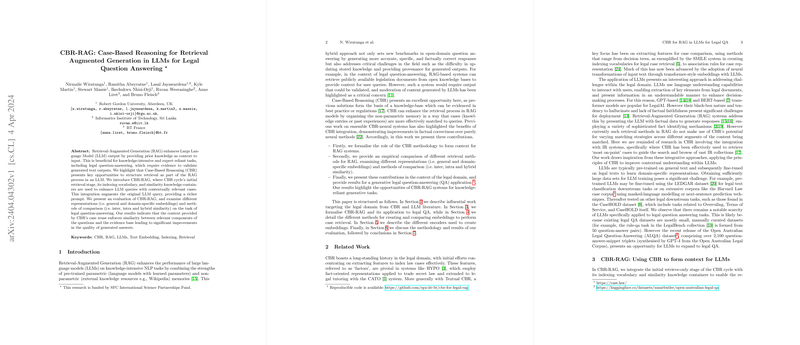An Overview of CBR-RAG: Enhancing Legal Question Answering through Case-Based Reasoning and Retrieval-Augmented Generation
In the context of enhancing LLMs for knowledge-intensive tasks, Retrieval-Augmented Generation (RAG) serves as a paradigm designed to combine both parametric and non-parametric resources. The research conducted by Wiratunga et al. introduces CBR-RAG, an intricate methodology that leverages Case-Based Reasoning (CBR) as a structural foundation to augment the retrieval process essential for RAG systems. Specifically tailored for the legal domain, this approach augments LLMs to handle complex legal question-answering tasks that require precise alignment with legal precedents and regulatory frameworks.
Methodological Insights
CBR-RAG incorporates the foundational principles of CBR into the retrieval stage of the RAG process. The predominant idea is to use past legal cases to enhance the contextual understanding of LLM queries. Here, the CBR methodology's indexing vocabulary and similarity assessments play a crucial role in aligning cases with the input query, thus augmenting the query with a contextually rich prompt for LLMs. The introduction of different representations through neural embeddings, alongside intra and inter-embedding comparisons, enriches this paradigm by offering varied perspectives on retrieval efficiency and semantic similarity.
Strong Numerical Results
The paper reports commendable outcomes through empirical evaluations. By employing distinct embeddings sourced from BERT, LegalBERT, and AnglEBERT models, the paper highlights how these models influence the retrieval quality and, subsequently, the generative accuracy of the system. Amongst the tested models, Hybrid AnglEBERT yielded superior results, improving the generative answer quality as measured through cosine similarity to a significant extent compared to a non-retrieval baseline (No-RAG).
Implications and Future Prospects
The implications of integrating CBR with RAG are multifaceted. Practically, this approach has the potential to transform legal AI systems by providing more accurate and contextually anchored responses. Theoretically, it offers a robust framework for extending retrieval methodologies within generative models by using past cases as a knowledge base, enabling more nuanced similarity assessments and context generation.
The paper draws attention to the potential advantages of contrastive optimization methods as used in AnglEBERT, notably in capturing nuanced legal semantics, over traditional BERT-style self-supervision. The substantial improvement witnessed in semantic similarity when using AnglEBERT suggests the efficacy of contrastive learning in tailored retrieval and highlights an area ripe for further investigation.
Conclusion
CBR-RAG stands as a significant contribution to the intersection of legal AI and advanced natural language processing, bringing to the forefront the importance of structured retrieval mechanisms in generative models. As the field progresses, future work might explore case aggregation strategies and the fine-tuning of legal datasets to further enhance the applicability and accuracy of these systems in legal domains. By merging strengths from CBR and RAG, this research sets a promising path for the development of more intelligent, contextually aware AI systems within the legal framework, a testament to the evolving capabilities of AI in specialized disciplines.
